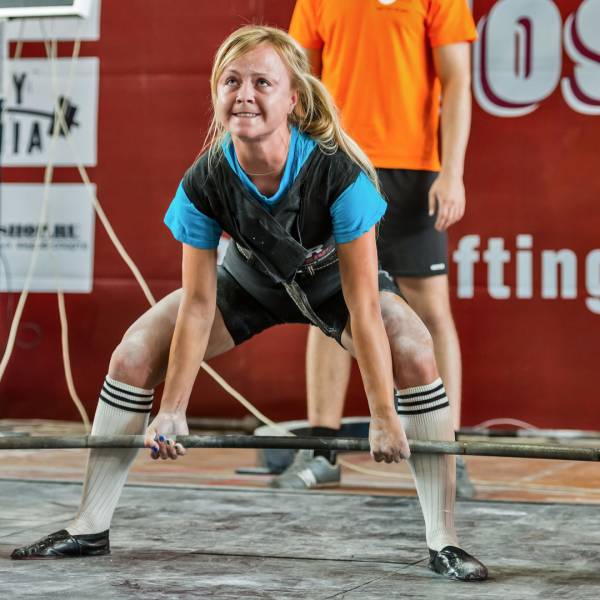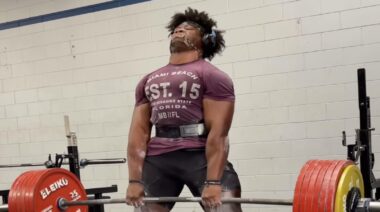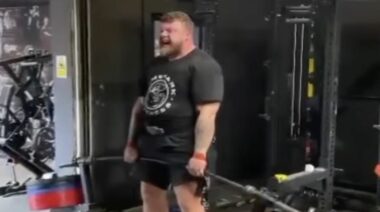No exercise is quite as feared, or revered, as the barbell deadlift. It is probably the oldest barbell exercise in existence. The day the barbell was invented, you can bet someone tried to pick it up off the floor. It is the obvious thing to do with a barbell, isn’t it?
No exercise is quite as feared, or revered, as the barbell deadlift. It is probably the oldest barbell exercise in existence. The day the barbell was invented, you can bet someone tried to pick it up off the floor. It is the obvious thing to do with a barbell, isn’t it?
To be crystal clear, there is absolutely nothing unsafe about a correctly performed deadlift.1 In fact, learning to correctly lift something heavy off the floor is one of the best investments you can make for your training.2 Anyone who claims that deadlifts are unsafe makes it immediately clear that they do not understand how to deadlift. As such, they are 100% correct; deadlifts dangerous for them. Improper deadlifts are indeed unsafe.3
Not All Deadlifts are Equal
Specific arthrometric considerations can determine the best way for you to deadlift. Many believe that you should only deadlift with a conventional stance, or a sumo stance, or some other specific method. We are not all built the same, so why should we all perform a movement the same?4 It’s perfectly normal to change your grip width for the bench press or your stance in the squat. The same applies to the deadlift.
First, let’s define the deadlift as lifting a barbell from the floor.5 Rather than consider the Romanian deadlift, rack pull, and other variations, this article will strictly discuss deadlifts from the floor.
The two main types of barbell deadlifts are the conventional deadlift and the sumo deadlift.
Convention vs. Sumo
The conventional and sumo deadlift both use a straight bar and begin at the floor. Both are a hip hinge movement, meaning that the hip extensors (glutes and hamstrings) are the primary movers. The mechanics differ slightly for each variation due to stance and placement of the load relative to the body. However, the hip extensors are always the primary muscle group trained in any deadlift.
Many will argue that one variation or the other is safer, better for developing specific body parts, or better for certain athletes. You are far better served to allow your anatomy to dictate how to pull from the floor than any misguided idea to target different muscles. Performing the right variation will allow you to lift more weight in a safer fashion.6 I have yet to see any evidence that lifting more weight with less risk of injury is a bad thing.
Choosing the Right Deadlift for You
Below are some guidelines to determine which variation is best for you.
| Choose the conventional deadlift if you have: | Choose the sumo deadlift if you have: |
|---|---|
| Short femurs | Long femurs |
| Long arms | Short arms |
| Neutral hips | Retroverted hips |
| Good hip internal rotation | Limited hip internal rotation |
| Good hip flexion | Limited hip flexion |
Not sure what any of these terms mean? Some are self-explanatory, such as long femurs. A good coach or physical therapist can assist you. You can also use hip tests on YouTube to determine for yourself.
A Third Option?
Trap bar deadlifts are another deadlift variation that uses a trap bar rather than a straight barbell. Trap bar deadlifts are controversial, as some consider them not a “real” deadlift. They are no better or worse than the other deadlift variations; they are simply different.7
Trap bar deadlifts are prominent in strength and conditioning gyms and are a staple in any sporting club gym or university gym. They are generally easier to teach, an important consideration when training large groups. If you have access to a trap bar but no good coach, the trap bar is perhaps a better option for you.
Modifying for Your Body
I began the article by stating that a deadlift always begins from the floor. While generally true, there are those who, due to anatomy or previous injury, simply cannot perform a proper deadlift from the floor. If this is you, are you better to push through and grind out deadlifts with less than proper technique? Of course not. Raise the damn bar!

Only powerlifters truly need to deadlift from the floor, as the rules of their sport require. Use blocks to reduce the range of motion of your deadlifts. If your choice is between deadlifting from blocks or not deadlifting, you should deadlift from blocks. This does not need to be a permanent change. If returning from injury, simply lower the starting height as you become more comfortable deadlifting.
Your main priority is quality and longevity. If you are to take away one thing from this article, let it be this: pick the deadlift variation that suits your body type and enables you to lift the most weight in the safest fashion.
References:
1. Ross, Michael D. “Low Back Disorders: Evidence-Based Prevention and Rehabilitation.” Physical Therapy 83, no. 8 (2003): 752.
2. Frost, David, Jordan Andersen, Thomas Lam, Tim Finlay, Kevin Darby, and Stuart McGill. “The relationship between general measures of fitness, passive range of motion and whole-body movement quality.” Ergonomics 56, no. 4 (2013): 637-649.
3. McGill, Stuart M. “Low back exercises: evidence for improving exercise regimens.” Physical therapy 78, no. 7 (1998): 754-765.
4. McGill, Stuart. Ultimate back fitness and performance. Backfitpro Incorporated, 2009.
5. McGuigan, Michael RM, and Barry D. Wilson. “Biomechanical Analysis of the Deadlift.” The Journal of Strength & Conditioning Research 10, no. 4 (1996): 250-255.
6. Belcher, Daniel. “The Sumo Deadlift.” Strength & Conditioning Journal 39, no. 4 (2017): 97-104.
7. Swinton, Paul A., Arthur Stewart, Ioannis Agouris, Justin WL Keogh, and Ray Lloyd. “A biomechanical analysis of straight and hexagonal barbell deadlifts using submaximal loads.” The Journal of Strength & Conditioning Research 25, no. 7 (2011): 2000-2009.






